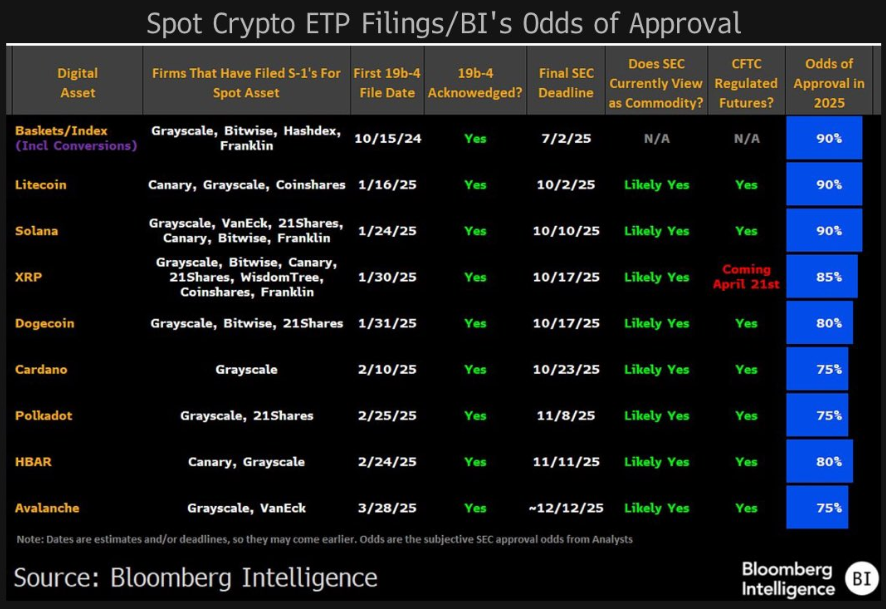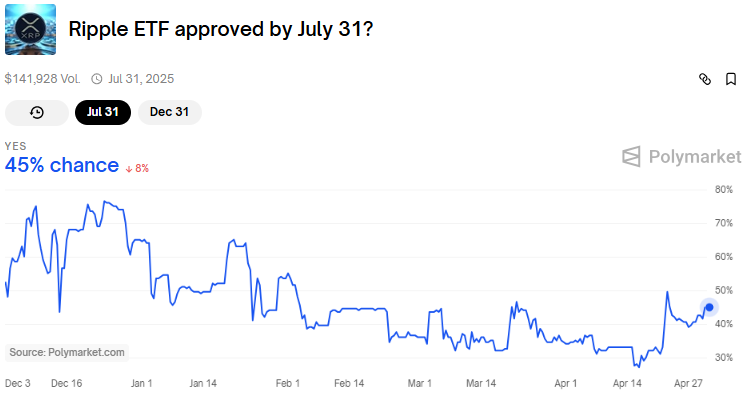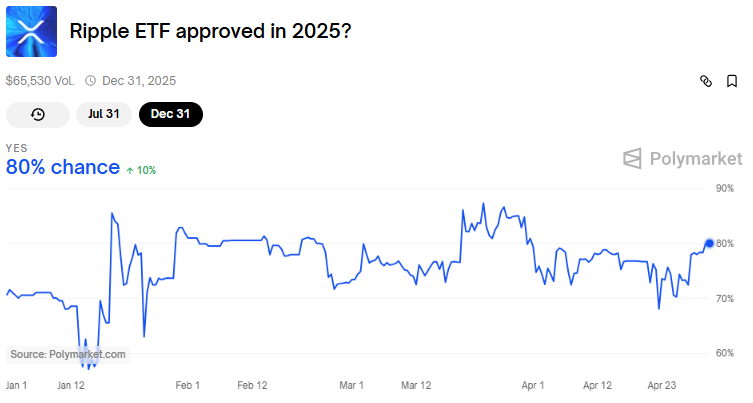Welcome to the US Morning Crypto News Briefing—your essential rundown of the most important developments in crypto for the day ahead.
Grab a coffee to see what experts think about the Ripple price given the growing approval odds for XRP ETF (exchange-traded funds) in the US. These financial instruments offer investors indirect exposure to crypto and progressively draw institutional players to the digital assets space.
XRP ETF Approval Odds Soar to 85%
The crypto market remains euphoric about Paul Atkins’s ascension to the position of chair of the US SEC (Securities and Exchange Commission).
There is a lot of hope and optimism about what his appointment means for crypto, coming after a season of repressive regulation from his predecessor, Gary Gensler.
After positive breaks in lawsuits against crypto firms and reversals of oppressive banking regulations, what comes next?
For one, the market anticipates the implementation of a Strategic Bitcoin Reserve, with the US on course to become a global Bitcoin Superpower.
Meanwhile, ETF analyst Eric Balchunas has appealed to Paul Atkins for hints about when the US SEC will approve the first spot XRP ETF, among other altcoin-based financial instruments.
He and his colleague, ETF analyst James Seyffart, remain optimistic that approving additional altcoin-related ETFs beyond Ethereum is only a matter of time.
“Would love to hear directly from Atkins, but all good chance of happening,” Balchunas posed.
Specifically, for them, XRP ETF holds an 85% chance of approval, placing it among the frontrunners for regulatory approval in 2025. Balchunas also shared a list outlining the approval probabilities for various spot crypto ETFs.

Meanwhile, Seyffart notes that delays in approval should not come as a surprise. He urges crypto market participants to hold out hope beyond October 2025 and year-end in the worst-case scenario.
“…Final deadlines for most of this stuff is in October 2025 or later,” Seyffart stated.
However, Balchunas acknowledges that Paul Atkins’s confirmation as the new SEC chair has set the ball rolling.
“…nothing was going to get approved until Atkins was confirmed…he just got confirmed and they’ve been taking outside meetings with people. Probably coming up with a strategy. After that, likely approvals,” Balchunas opined.
Crypto traders and investors would surely welcome more altcoin-based exchange-traded funds beyond the Ethereum ETF. Such financial instruments would give crypto more legitimacy, open the playing field for institutional participation, and, hence, increase liquidity.
A recent US Crypto News publication indicated growing adoption for BTC over gold, ascribing the traction to Bitcoin ETF inflows surging against lagging gold ETPs (exchange-traded products).
ProShares Futures XRP ETP To Begin Trading
Meanwhile, these developments come after false rumors circulated, alleging that the US SEC approved an XRP ETF. However, BeInCrypto invalidated these claims, clarifying that only leveraged and short XRP futures ETFs were authorized to trade starting April 30.
Despite the false claims, the approval of ProShares’ XRP futures ETF sparked optimism. Experts now predict that a spot XRP ETF could follow, potentially attracting $100 billion to the payments token.
“A spot XRP ETF could be next, unlocking real demand and sending prices soaring. $100 billion+ could soon flood into XRP,” wrote industry expert Armando Pantoja.
Against this backdrop, analysts say an approval could see XRP price rally by nearly 50%, potentially reaching the $3.40 level. Others also suggest that XRP could surpass Ethereum on market capitalization metrics.
Charts of the Day

This chart shows Polymarket bettors see a 45% chance the US SEC will approve XRP ETFs in the US by July 31.

This chart shows that Polymarket bettors see an 80% chance the US SEC will approve XRP ETFs in the US before the end of the year or within 2025.
Byte-Sized Alpha
- Trump Media & Technology Group (TMTG) is exploring a utility token to enhance the Truth+ platform and diversify revenue streams.
- US spot Bitcoin ETFs saw $172.78 million in net inflows Tuesday, marking the 8th straight day of institutional bullishness.
- Bitcoin supply on centralized exchanges hit a 7-year low, easing selling pressure and supporting bullish price momentum.
- Cardano whales accumulated over 420 million ADA in April, signaling confidence despite ADA’s price struggles below key resistance levels.
- Ethereum faces a narrative crisis as its community debates whether to focus on revenue or store of value (SoV).
- Alex Thorn of Galaxy Digital warns that quantum computing is a much bigger threat to Bitcoin than many realize, with uncertain solutions ahead.
- Peter Todd’s proposal to lift OP_RETURN size limits has sparked a heated debate. Supporters cite improved efficiency and use cases for sidechains.
- Libre launches a $500 million Telegram Bond Fund on the TON blockchain, tokenizing Telegram’s debt to offer fixed-income products.
Crypto Equities Pre-Market Overview
| Company | At the Close of April 29 | Pre-Market Overview |
| Strategy (MSTR) | $381.45 | $379.70 (-0.46%) |
| Coinbase Global (COIN) | $206.13 | $205.69 (-0.21%) |
| Galaxy Digital Holdings (GLXY.TO) | $21.09 | $20.97 (-0.57%) |
| MARA Holdings (MARA) | $14.22 | $14.16 (-0.42%) |
| Riot Platforms (RIOT) | $7.42 | $7.38 (-0.54%) |
| Core Scientific (CORZ) | $8.29 | $8.25 (-0.48%) |
The post XRP Spot ETF Approval Odds Rise to 85% for 2025 | US Crypto News appeared first on BeInCrypto.




